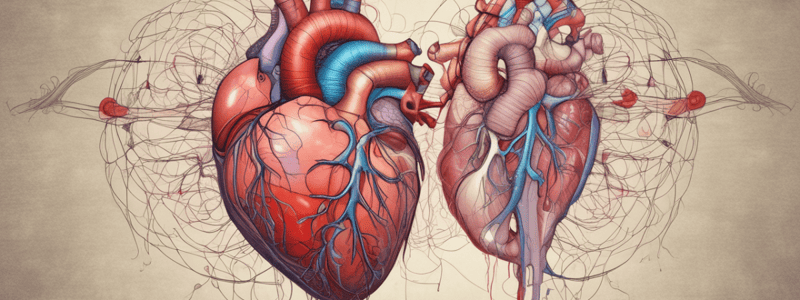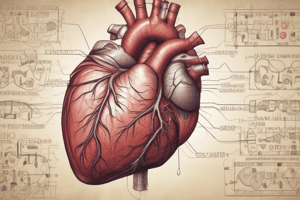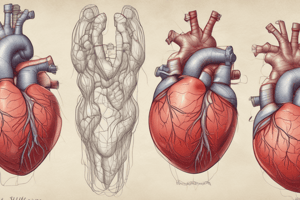Podcast
Questions and Answers
What is the common characteristic of cyanotic heart defects?
What is the common characteristic of cyanotic heart defects?
- Right-to-left cardiac shunt (correct)
- No cardiac shunt
- Left-to-right cardiac shunt
- Both left-to-right and right-to-left cardiac shunt
Which of the following is a common cause of cyanotic heart defects?
Which of the following is a common cause of cyanotic heart defects?
- Infections during pregnancy
- Maternal conditions
- Genetic defects
- Both maternal conditions and genetic defects (correct)
What is the typical clinical manifestation of cyanotic heart defects?
What is the typical clinical manifestation of cyanotic heart defects?
- Heart failure
- Cyanosis (correct)
- Cardiac arrest
- Failure to thrive
How are cyanotic heart defects typically diagnosed?
How are cyanotic heart defects typically diagnosed?
What is the typical treatment for heart defects that require intervention?
What is the typical treatment for heart defects that require intervention?
What is a common symptom of cyanotic heart defects?
What is a common symptom of cyanotic heart defects?
What is the prognosis for untreated cyanotic heart defects?
What is the prognosis for untreated cyanotic heart defects?
What is the pathophysiological characteristic of cyanotic heart defects?
What is the pathophysiological characteristic of cyanotic heart defects?
Which of the following is a supportive medical therapy for patients with heart failure?
Which of the following is a supportive medical therapy for patients with heart failure?
What is the common feature among Tetralogy of Fallot, Transposition of the great vessels, Tricuspid valve anomalies, Total anomalous pulmonary venous return, and persistent Truncus arteriosus?
What is the common feature among Tetralogy of Fallot, Transposition of the great vessels, Tricuspid valve anomalies, Total anomalous pulmonary venous return, and persistent Truncus arteriosus?
What is the purpose of administering prostaglandin E1 infusion in ductal-dependent CHDs?
What is the purpose of administering prostaglandin E1 infusion in ductal-dependent CHDs?
What is the primary reason for cyanosis in cyanotic CHDs?
What is the primary reason for cyanosis in cyanotic CHDs?
Which of the following is NOT a characteristic of Tetralogy of Fallot?
Which of the following is NOT a characteristic of Tetralogy of Fallot?
What is the goal of diuretic therapy in patients with heart failure?
What is the goal of diuretic therapy in patients with heart failure?
Why is antibiotic prophylaxis necessary during dental procedures for patients with unrepaired cyanotic CHDs?
Why is antibiotic prophylaxis necessary during dental procedures for patients with unrepaired cyanotic CHDs?
What is the primary cause of 'blue baby' syndrome?
What is the primary cause of 'blue baby' syndrome?
Which of the following conditions is a risk factor for CHDs?
Which of the following conditions is a risk factor for CHDs?
What is the purpose of surgical repair in patients with CHDs?
What is the purpose of surgical repair in patients with CHDs?
What is the survival rate of patients with TGA without treatment?
What is the survival rate of patients with TGA without treatment?
What is the primary communication between the right and left heart in tricuspid valve atresia?
What is the primary communication between the right and left heart in tricuspid valve atresia?
What is the characteristic of the tricuspid valve in Ebstein anomaly?
What is the characteristic of the tricuspid valve in Ebstein anomaly?
What is the primary consequence of tricuspid regurgitation in Ebstein anomaly?
What is the primary consequence of tricuspid regurgitation in Ebstein anomaly?
What is the characteristic feature of total anomalous pulmonary venous return (TAPVR)?
What is the characteristic feature of total anomalous pulmonary venous return (TAPVR)?
What is the typical clinical manifestation of tricuspid valve atresia?
What is the typical clinical manifestation of tricuspid valve atresia?
What is the confirmatory test for tricuspid valve atresia?
What is the confirmatory test for tricuspid valve atresia?
What is the pathophysiological feature of Ebstein anomaly?
What is the pathophysiological feature of Ebstein anomaly?
What is the characteristic feature of the right ventricle in tricuspid valve atresia?
What is the characteristic feature of the right ventricle in tricuspid valve atresia?
What is the most common cyanotic congenital heart defect?
What is the most common cyanotic congenital heart defect?
What is the cause of Tet spells in Tetralogy of Fallot?
What is the cause of Tet spells in Tetralogy of Fallot?
What is the characteristic heart shape on a chest x-ray in Tetralogy of Fallot?
What is the characteristic heart shape on a chest x-ray in Tetralogy of Fallot?
What is the treatment for severe RVOTO in Tetralogy of Fallot?
What is the treatment for severe RVOTO in Tetralogy of Fallot?
What is the definition of Transposition of the great vessels?
What is the definition of Transposition of the great vessels?
What is the pathophysiology of Transposition of the great vessels?
What is the pathophysiology of Transposition of the great vessels?
What is the characteristic chest x-ray finding in Transposition of the great vessels?
What is the characteristic chest x-ray finding in Transposition of the great vessels?
What is the initial postnatal management of Transposition of the great vessels?
What is the initial postnatal management of Transposition of the great vessels?
What is the association of Tetralogy of Fallot with genetic disorders?
What is the association of Tetralogy of Fallot with genetic disorders?
What is the primary mechanism of right-to-left shunting in total anomalous pulmonary venous return?
What is the primary mechanism of right-to-left shunting in total anomalous pulmonary venous return?
What is the most common cardiac defect associated with persistent truncus arteriosus?
What is the most common cardiac defect associated with persistent truncus arteriosus?
What is the primary function of the PDA in hypoplastic left heart syndrome?
What is the primary function of the PDA in hypoplastic left heart syndrome?
What is the characteristic cardiac examination finding in patients with persistent truncus arteriosus?
What is the characteristic cardiac examination finding in patients with persistent truncus arteriosus?
What is the role of the RV in hypoplastic left heart syndrome?
What is the role of the RV in hypoplastic left heart syndrome?
What is the initial medical management for hypoplastic left heart syndrome?
What is the initial medical management for hypoplastic left heart syndrome?
What is the pathophysiological mechanism of cyanosis in total anomalous pulmonary venous return?
What is the pathophysiological mechanism of cyanosis in total anomalous pulmonary venous return?
What is the characteristic chest x-ray finding in total anomalous pulmonary venous return?
What is the characteristic chest x-ray finding in total anomalous pulmonary venous return?
What is the etiology of persistent truncus arteriosus?
What is the etiology of persistent truncus arteriosus?
Flashcards are hidden until you start studying
Study Notes
Cyanotic Heart Defects (CHDs)
- Congenital cardiac malformations affecting atrial walls, ventricular walls, heart valves, or large blood vessels
- Common causes: genetic defects, maternal conditions (e.g., diabetes), and spontaneous genetic mutations
- Pathophysiology: right-to-left cardiac shunt, leading to deoxygenated blood entering the systemic circulation, resulting in hypoxemia and cyanosis
Symptoms and Diagnosis
- Symptoms: cyanosis, failure to thrive, characteristic heart murmurs, and symptoms of heart failure
- Diagnosis: confirmed through echocardiography, with low oxygen saturation and characteristic x-ray findings
Treatment and Prognosis
- Heart defects requiring treatment are repaired via catheter procedures or surgery
- Supportive medical therapy is required in patients with heart failure or if surgery cannot be performed
- If untreated, most cyanotic heart defects are fatal within the first year of life
Associated Conditions and Risk Factors
- Tetralogy of Fallot
- DiGeorge syndrome
- Down syndrome
- Maternal risk factors: alcohol consumption, phenylketonuria, and diabetes
- Tricuspid valve atresia
- Total anomalous pulmonary venous return
- Heterotaxy syndromes
- Persistent truncus arteriosus
- Hypoplastic left heart syndrome
General Pathophysiological Processes
- Right-to-left cardiac shunting: deoxygenated blood entering the systemic circulation, leading to cyanosis
- Fetal and postnatal circulation: changes in blood flow and oxygenation during development
Topic-Specific Notes
Tetralogy of Fallot
- Definition: simultaneous occurrence of four defects: RVOTO, RVH, VSD, and overriding aorta
- Epidemiology: most common cyanotic CHD
- Etiology: typically sporadic, associated with genetic disorders (DiGeorge syndrome, Down syndrome)
- Pathophysiology: anterior and superior deviation of the infundibular septum during fetal development
- Clinical findings: cyanosis, RVOTO, and characteristic cardiac examination findings
- Treatment: surgical repair, PGE1 infusion, and treatment of tet spells
Transposition of the Great Vessels (TGV)
- Definition: anatomical reversal of the aorta and pulmonary artery
- Etiology: failed spiraling of the aorticopulmonary septum during fetal development
- Pathophysiology: complete isolation of the pulmonary and systemic circuits, leading to cyanosis
- Clinical findings: postnatal cyanosis, tachypnea, and single, loud S2
- Treatment: mixing of the two parallel circulations, balloon atrial septostomy, and surgical repair
Tricuspid Valve Atresia
- Definition: absent or rudimentary tricuspid valve
- Pathophysiology: RV hypoplasia, RA dilation, and interatrial and interventricular communications
- Clinical findings: cyanosis, tachypnea, and cardiac examination findings
- Treatment: cardiopulmonary stabilization, PGE1 infusion, and surgical palliation
Ebstein Anomaly
- Definition: malformed tricuspid valve leaflets displaced into the RV
- Pathophysiology: incomplete delamination during valve development, leading to tricuspid regurgitation and RV atrialization
- Clinical findings: cyanosis, cardiomegaly, and cardiac examination findings
- Treatment: surgical repair
Total Anomalous Pulmonary Venous Return (TAPVR)
- Definition: all four pulmonary veins draining into the systemic venous circulation
- Pathophysiology: venous mixing, leading to right-to-left shunting and cyanosis
- Clinical findings: cyanosis, respiratory failure, and cardiac examination findings
- Treatment: surgical repair
Persistent Truncus Arteriosus
- Definition: underdevelopment of the aorticopulmonary septum, resulting in a single trunk
- Pathophysiology: deoxygenated and oxygenated blood mix via a VSD
- Clinical findings: cyanosis, respiratory distress, and cardiac examination findings
- Treatment: surgical repair
Hypoplastic Left Heart Syndrome (HLHS)
- Definition: spectrum of disease consisting of severe hypoplasia of the left ventricle
- Pathophysiology: hypoplastic left ventricle is nonfunctional, with RV becoming the primary supply for pulmonary and systemic circulations
- Clinical findings: cyanosis, tachypnea, and cardiac examination findings
- Treatment: initial medical management, PGE1 infusion, and surgical repair
Studying That Suits You
Use AI to generate personalized quizzes and flashcards to suit your learning preferences.




